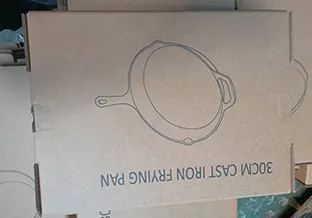
Benefits of Using an Iron Frying Pan for Healthier Cooking
The Iron Frying Pan A Cookware Classic
In the world of culinary tools, few items hold as much reverence as the iron frying pan, also known as a cast iron skillet. This trusty piece of cookware has been a staple in kitchens around the globe for centuries, transcending trends and evolving into a must-have for both amateur cooks and professional chefs. Its durability, heat retention, and versatility make it an exceptional choice for a wide range of cooking techniques.
Historical Significance
The history of cast iron cookware dates back to the Han Dynasty in China, where it was first developed around 200 BCE. Cast iron skillets made their way to Europe through trade and gradually became popular during the 18th century. The introduction of the cast iron frying pan to American kitchens in the early 19th century marked a significant turning point in cooking practices. Brands like Lodge and Griswold began mass-producing these pans, making them accessible to households and establishing a legacy that continues to this day.
Benefits of Using an Iron Frying Pan
One of the primary advantages of an iron frying pan is its ability to retain heat. Unlike other materials, cast iron can reach high temperatures and hold that heat for extended periods, making it ideal for searing meat. This characteristic is particularly important for achieving a perfect crust on steak or chicken. The heat retention also contributes to a consistent cooking temperature, ensuring that food is cooked evenly.
Another notable benefit is its versatility. Iron frying pans can be used on the stovetop, in the oven, or even over an open flame. This means that you can start a dish on the stove and finish it in the oven without having to transfer to another vessel. The pan is perfect for a wide variety of cooking techniques, including frying, sautéing, baking, and roasting.
iron frying pan

Furthermore, cast iron skillets have a unique ability to develop a natural nonstick surface over time, a process that occurs through seasoning. Seasoning involves applying a layer of oil to the pan and heating it, which creates a polymerized layer on its surface. This not only prevents food from sticking but also enhances the flavor of the dishes cooked in it. With proper care, an iron frying pan can last a lifetime, often becoming a cherished family heirloom.
Maintenance and Care
To maintain the integrity and performance of an iron frying pan, a few simple practices should be followed. After each use, it is essential to clean the skillet without using soap, as this can strip away the seasoned layer. Instead, rinsing it with hot water and using a stiff brush to remove food particles is recommended. For tough stuck-on bits, a small amount of coarse salt can be used as an abrasive.
Once cleaned, the skillet should be dried thoroughly to prevent rust. A light coat of cooking oil can also be applied before storing to keep the seasoning intact. It's worth noting that an iron frying pan requires a bit more care than nonstick pans, but this investment pays off in flavor and longevity.
Conclusion
The iron frying pan is more than just a cooking tool; it is a symbol of culinary tradition and a testament to the art of cooking. Its enduring presence in kitchens across generations is a reflection of its reliability and effectiveness. As food enthusiasts continue to explore new recipes and cooking methods, the iron frying pan remains an essential companion, helping to create delicious meals filled with love and flavor. Whether you are frying pancakes for breakfast, searing a juicy steak for dinner, or baking a cornbread, the iron frying pan is sure to deliver exceptional results, making it a classic choice for any home cook. Embrace the legacy of this remarkable cookware and discover the countless delicious possibilities it brings to your kitchen.
-
Premium Skillets Sets - Porcelain & Enamel Covered Cast Iron Cookware for Every KitchenNewsJun.24,2025
-
Premium Deep Cast Iron Pan – Versatile Enameled & Grill Options, Perfect for Frying and SaucesNewsJun.10,2025
-
Chipped Enamel Dutch Oven – Durable & Stylish Kitchen Essential for Even CookingNewsJun.10,2025
-
Best Cast Iron Cookware Set Sale Durable Pots & Woks DealsNewsJun.09,2025
-
Hanging Dutch Oven Oven Safe & Lid IncludedNewsJun.09,2025
-
16 Inch Dutch Oven - Heavy Duty Cast Iron for Large MealsNewsJun.09,2025


